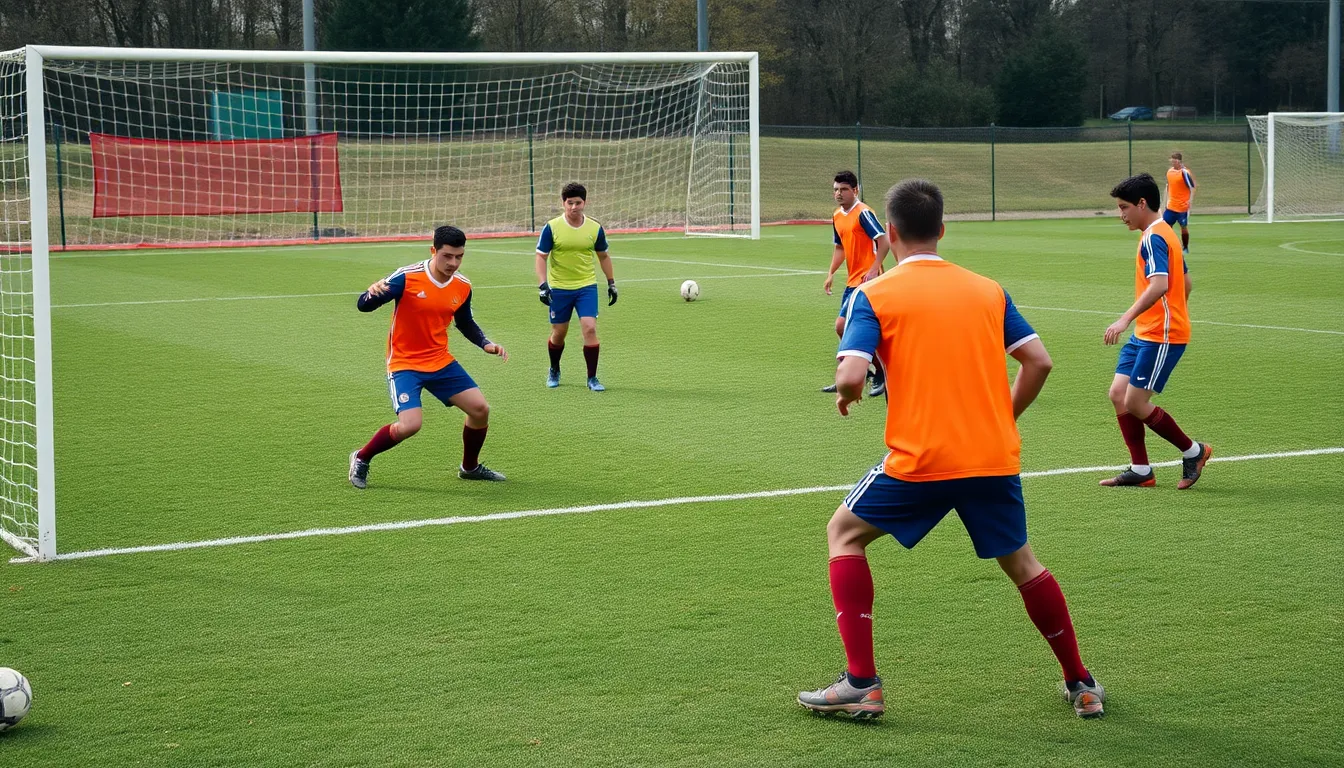In the world of football management, squad tactics can make or break a season. Imagine orchestrating a symphony where every player hits the right note. That’s the art of FM squad tactics. It’s not just about picking the best players; it’s about unleashing their potential and creating a strategy that leaves opponents scratching their heads.
Whether you’re a seasoned manager or a rookie navigating the transfer market, mastering these tactics can transform your team from underdogs to champions. With the right approach, you can outsmart rivals and lead your squad to glory. So grab your tactical board and get ready to dive into the fascinating realm of FM squad tactics, where every decision counts and a little creativity goes a long way. After all, who doesn’t want to be the mastermind behind a winning team?
Table of Contents
ToggleOverview of FM Squad Tactics
FM squad tactics focus on optimizing player roles and formations to enhance team performance. Managerial strategies emphasize player strengths, ensuring alignment with overall team objectives. Creating a balance between defensive solidity and attacking flair proves vital for successful gameplay.
Understanding positional play aids managers in making tactical decisions. Recognizing when to implement high pressing or sit deep helps in adapting to opponents. Each team requires a unique approach to capitalize on its strengths while mitigating weaknesses.
Utilizing formations like 4-4-2 or 4-3-3 can dictate gameplay dynamics. Different setups allow for varied tactical maneuvers, giving managers the flexibility to adapt during matches. Incorporating strategies such as fluid attacking movements leads to better goal-scoring opportunities.
Effective communication among players plays an essential role in executing tactics. Players must comprehend their responsibilities within the chosen formation, enhancing on-field coordination. Feedback during matches allows adjustments to improve team performance.
Data analytics informs decision-making for squad development. By analyzing player statistics, managers can identify trends that shape their tactical approach. Adopting innovative tactics keeps teams ahead of opponents, enhancing competitiveness in various scenarios.
Implementing these tactics requires ongoing evaluation. Monitoring performance provides insights for future matches, allowing for adjustments as needed. Continual refinement of tactics leads to improved outcomes and sustained success in football management.
Key Principles of FM Squad Tactics

FM squad tactics revolve around optimizing player strengths and forming cohesive unit dynamics. Understanding each element helps managers enhance team performance.
Squad Composition
Squad composition significantly impacts overall success. Selecting a balanced mix of skilled players ensures coverage across all positions. Consider including specialists for specific roles like playmaker or defensive anchor. Managers often assess player attributes such as speed, agility, and tactical awareness to build effective lineups. Different formations, like 4-3-3 or 4-4-2, tailor squad arrangements to accommodate varied tactical approaches. A well-rounded squad provides more options and adaptability during matches. Players with complementary skills enhance teamwork and create competitive edges against opponents.
Roles and Responsibilities
Defining clear roles and responsibilities boosts tactical effectiveness. Each player requires a distinct set of duties to meet overall strategic goals. Goalkeepers focus on shot-stopping and commanding the area. Center-backs prioritize marking and breaking up attacks. Midfielders must balance between defensive cover and attacking support. Forwards typically take charge of finishing opportunities and creating threats. Managers clarify expectations through ongoing communication, ensuring everyone understands their contributions. Detailed role assignments foster accountability, allowing players to execute tactics with precision. Adaptations can occur based on match context, ensuring fluidity and responsiveness in play.
Tactical Strategies in FM
Tactical strategies in FM play a crucial role in shaping a team’s performance on the pitch. Managers focus on specific approaches to maximize their team’s strengths while addressing weaknesses.
Offensive Tactics
Utilizing offensive tactics effectively can lead to increased goal-scoring opportunities. Managers often implement formations such as 4-3-3, allowing wingers to stretch defenses. Additionally, quick transition play and fluid movement create space, enabling strikers to capitalize on scoring chances. High pressing can disrupt opponent build-up, creating turnovers in advantageous areas. Players must understand their roles within the attacking structure, ensuring they maintain support and positional awareness. Continuous adjustments based on match progression enhance offensive fluidity and effectiveness.
Defensive Tactics
Employing solid defensive tactics is essential for maintaining team stability. Many managers prefer formations like 4-4-2, which provide a strong defensive base. Players should prioritize organization and discipline, responding swiftly to opponents’ movements. Utilizing low-block tactics can frustrate aggressive attacks, forcing opponents into predictable patterns. Clear communication among defenders helps maintain shape and coverage. Additionally, focusing on individual responsibilities fosters cohesion, ensuring every player contributes to overall defensive resilience. Adaptations during matches allow teams to respond dynamically to threats and retain control.
Training and Implementation
Effective training and implementation of FM squad tactics require structured approaches and comprehensive drills. Managers must engage players through targeted exercises that enhance understanding of tactical principles.
Drills and Exercises
Drills for tactical training often include specific simulations of match scenarios. Positioning drills reinforce understanding of roles within formations like 4-3-3. Small-sided games, like 5v5 or 7v7, enable players to practice pressing and transitions. These exercises gauge players’ ability to adapt based on real-time situations. Regular repetition ensures a natural execution of tactics during competitive matches. Consistent feedback from coaches during drills helps players refine their technique and awareness.
Common Challenges
Adopting new tactics may present various challenges. Resistance to change can stem from players’ familiarity with previous systems. Miscommunication among team members during high-pressure situations often leads to tactical breakdowns. Limited understanding of specific roles can hinder effectiveness in formations. Additionally, injuries may disrupt the balance of squad dynamics. Coaches must address these challenges through continuous education and open lines of communication. Regular assessments help identify weaknesses and adapt training accordingly.
Case Studies and Examples
Analyzing successful football management tactics provides insight into effective squad deployment. For instance, Pep Guardiola’s use of the 4-3-3 formation at Manchester City emphasizes positional play and dynamic movement. Players like Kevin De Bruyne and Raheem Sterling thrive under such a system due to clear role definitions and the focus on fluid attack.
Examining Jürgen Klopp’s 4-3-3 approach at Liverpool reveals the effectiveness of high pressing. The team’s aggressive forward line, featuring players like Mohamed Salah and Sadio Mané, demonstrates the importance of teamwork and communication in executing pressing tactics. Key takeaway: adapting to opponents can lead to significant advantages on the field.
Another example includes Atlético Madrid’s implementation of the 4-4-2 formation under Diego Simeone. This formation showcases solid defensive organization, allowing the team to absorb pressure and counter-attack effectively. With players like Antoine Griezmann exploiting spaces, the defense and offense work in unison to achieve success.
In the lower leagues, teams like Luton Town use pragmatic tactics to maximize limited resources. Compact formations and organized defensive strategies emphasize the importance of maintaining stability. Such examples highlight how effective squad tactics can lead to unexpected victories.
Data analytics also play a vital role in modern football tactics. Teams analyze match statistics to determine optimal formations and player roles. Understanding player performance metrics can significantly influence tactical adjustments during matches.
Fostering strong team chemistry is crucial for executing tactical plans. Players need to understand their responsibilities to create a cohesive unit. Successful managers prioritize open communication to address tactical changes and reinforce strategy throughout the season.
Mastering FM squad tactics is essential for any football manager looking to elevate their team’s performance. By understanding player roles and optimizing formations, managers can create a cohesive unit that thrives on the pitch. The balance between offensive creativity and defensive solidity is vital for outsmarting opponents.
Effective communication and a clear definition of player responsibilities foster an environment where tactics can flourish. Embracing data analytics further enhances decision-making, allowing managers to adapt strategies in real-time. Ultimately, the journey to tactical excellence involves continuous learning and adaptation, ensuring that teams remain competitive and successful in the ever-evolving landscape of football.




